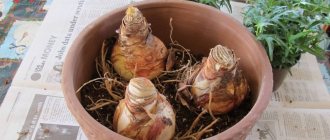Category: Succulents, Care Published 02/18/2019 · Comments: · Reading time: 9 min · Views: 1,770
Rowley's ragwort is one of the representatives of a huge family that stands out from other species; it resembles a scattering of bright green, juicy pearls or peas. But it is valued not only for its spectacular appearance; the plant has a tremendous will to live and can live in conditions that are far from comfortable.
Of course, flower growers are not recommended to test their green pet’s “strength” and it is advisable to provide it with suitable conditions and good care. And then the Rowley ragwort will look luxurious, shimmering with emerald green.
Briefly about the plant ragwort rowley
In African countries, ragwort is called “Strings of Pearls”. Under natural conditions, it grows in the mountains where there is little rain, so its tissues and leaves accumulate moisture to survive drought. Thanks to this adaptation of the plant, the leaves have acquired a ball-like shape, and the rowley ragwort has a dense skin.
It grows quickly and can reach a height of two meters when grown in hot climates. On window sills in apartments, its height usually reaches no more than 50 centimeters. Rowley ragwort does not need to be shaped or trimmed; the stems intertwine and branch on their own.
Raspberry can be grown as an ampel or ground cover. The plant quickly adapts to almost any conditions. Despite its African roots, Rowley's ragwort is considered unpretentious. It is not afraid of direct sunlight or complete shade, drought and temperature drops of up to 10 degrees. But under prolonged negative conditions, the stems become elongated, the leaves become small, and it stops blooming.
What conditions need to be created at home?
It is necessary to take into account the tropical origin of Rowley's ragus, creating the conditions necessary for its normal development.
Lighting
Rowley's ragwort requires bright light and does well even in direct sunlight. However, during the hottest period from 12 to 15 hours, the plant needs to be shaded. If the pot is on the windowsill, you should choose the south, east or west side of the apartment.
Ventilation
This succulent tolerates drafts well. Access to fresh air is always good for it, but you need to take into account the following - it does not tolerate sudden changes in temperature, and the air coming from the window should not differ much in temperature from the internal one. When it is warm outside, the godson is recommended to stay outside, but it must be protected from excessive rainfall and should be brought back into the house before it gets colder.
Temperature
The recommended temperature during the warm period for Rowley's ragwort is +23…+26°C. In winter, when the rest period begins, the temperature is set at +11...+15°C. At colder temperatures, the succulent begins to freeze, and at higher temperatures, it may begin to lose leaves.
Air humidity
This succulent has little demand for air humidity and tolerates the dry air of an ordinary apartment very well. The plant does not like waterlogging and tolerates the proximity of heating devices.
We recommend that you familiarize yourself with other varieties of succulents:
Description of the godson Rowley
At home, the ampelous ragus has a size of about 60 cm in length. But if it is grown in open ground, the flower can reach 2 m. The main feature of the ragwort is considered to be its fragile and elongated stems. The dark green, spherical leaves have a diameter of approximately 10 mm. There are small points at their ends. It looks like there are strings of beads hanging from the pot.
This exotic flower cannot be confused with any other
Breeders have developed a group of plants with high decorative properties - variegated groundsel (Variegata). This flower's leaves are arranged and grow randomly, with orange inclusions.
Rowley's ragwort is a perennial plant that is a member of the Asteraceae family.
Ampelous ragwort
Ragwort also has another name - green pearl. It is native to the arid regions of Namibia, which explains its low maintenance and resistance to climate change.
Botanical description of the plant
This perennial succulent is native to the highlands of Namibia, located in the southern African continent. It has long thin shoots with leaves in the form of small (6 mm) green balls. Thin rooted stems allow it to be used for pots and vertical gardening, as a ground cover; they can grow up to 1 m, and in natural conditions reach 2 meters in length. A variety has been developed with white spots on ball-shaped leaves.
At the end of the spring period, the interesting appearance of this succulent is complemented by flowering. The plant produces long flower stalks topped with light pink flowers that have a pleasant cinnamon scent.
Did you know? The genus Crosses includes 1587 species, among which there are a wide variety of plants - both annual herbs and trees.
| Root system | superficial |
| Stem | thread-like, hanging |
| Leaf Shape | spherical or oval |
| Leaf color | green |
| Flower shape | basket |
| Flower color | pale pink |
Caring for the Senecio rowleyanus flower at home
The requirements for growing ragwort are the same as for all succulents (plants that come from waterless areas). How to grow ragwort Rowley and provide him with care at home?
Illumination and temperature conditions
In summer, the most suitable temperature for a flower is 20-28 °C, and in winter - 10-15 °C. The plant is very light-loving, but, like other flowers, does not tolerate direct sunlight.
In which room is it better to put a money tree? Where to put a money tree according to Feng Shui rules
Watering rules and humidity
The ragwort can easily do without water. It is in excellent condition even during the winter heating season, when heaters significantly dry the air in the room. But in summer it should be watered regularly. At the same time, it is imperative to monitor the condition of the root system so that it does not begin to rot.
This flower does not need spraying. If there is oversaturation with moisture, the plant will lose its attractiveness: the stem will stretch, the leaves will begin to grow distant from each other, the foliage will lose its lushness and juiciness.
In winter, the frequency of watering is determined by the air temperature in the room. When staying in a warm room, the number of procedures is reduced (compared to summer). But if Rowley's ragwort is kept in a cool room, then watering is required once a month.
Fertilizing and soil quality
The most suitable soil for the plant is considered to be soil for succulents and cacti. In addition, perlite or crumbs (brick) are mixed into it.
If desired, you can prepare the soil yourself. For this purpose, the following ingredients are required (in equal parts):
- sand;
- peat soil;
- crumb (brick);
- leaf humus.
Flower container size
Senecio rowleyanus has a small root system, which is why the pot should be wide, but not deep. A drainage layer of fine crushed stone or expanded clay is laid at the bottom of the container.
Features of plant transplantation
A young plant must be replanted once a year, and an adult plant - once every 3-4 years (depending on the speed of growth and development). When replanting, it is imperative to follow safety precautions, since the flower is dangerous to humans. Also, the procedure is carried out very carefully due to the fragility of the roots and leaves.
Step-by-step instructions for transplantation:
- Fill the new container halfway with soil.
- Remove the plant (along with a small lump of soil) from the old pot.
- Place in a new pot and sprinkle with soil on all sides.
- Water, and next time only after two days.
Indoor strings of pearls
The plant, which resembles round peas strung on a green thread and creates amazing cascades, is very difficult to confuse with other succulents. Senecio Rowley is one of the most original and elegant types, which has become fashionable, first of all, among fans of hanging crops.
Senecio rowleyanus. Joyce-Tex-Buckner
Shiny and almost artificial in appearance, this amazing look with its clusters of polka dots is a miniature wonder that brings femininity and elegance to any interior.
Senecio rowleyanus, also known to us as Rowley's ragwort, emerald beads, is a magnificent succulent with very thin, almost thread-like, but quite rigid shoots, hanging down to a length of up to 50 cm.
The thick, rounded leaves actually look like bright green peas and are attached to the shoots by thin, short and easily broken petioles. The shoots are able to take root in the soil, and the leaves grow up to 6 mm in diameter.
Senecio Rowley is perfect for the role of an hanging plant. After all, its long and hanging shoots cannot be placed in any ordinary container, and they must hang freely from the edge of a pot or hanging basket.
The single flowers of senecio appear whimsical and fluffy, and do not resemble daisies in the same way as other types of ragworts. But winter flowering, which can last from November until July, can brighten up the cold months.
Senecio Rowley is so beautiful in itself that there are no varieties of the plant. The rich emerald color of this hanging succulent looks strikingly bright. Fans of this plant who are interested in similar forms may like the rooting ragwort (Senecio radicans), which has elongated, ovate leaves and a lighter, olive-gray color.
Rooting ragwort (Senecio radicans). JOY….^_^
Conditions and care for indoor godson Rowley
Rowley's ragwort is very easy to care for. Plants do not like too much watering, but are somewhat less tolerant of prolonged droughts. The soil should dry out between waterings, and in winter the humidity should be minimal. Feeding is carried out monthly from March to September. If desired, bare parts of the shoots or threads that are too elongated are cut off.
Senecio Rowley requires semi-shaded, bright or sunny locations. They grow well outdoors in summer, but can also be grown as indoor plants.
Cool keeping at a temperature of about 10 degrees stimulates flowering, but even without it, the groundsel retains its high decorative value. This plant is replanted only when the substrate is filled with roots in a special soil mixture for cacti.
Unfortunately, Senecio Rowley is not resistant to pests, but it is easy to propagate by cuttings or dividing large bushes.
See the continuation of the list of the most unusual succulents on the next page.
Types of ragworts
Raspberry is the largest genus among plants. Flower growers have managed to adapt almost all types of succulents to home conditions . But the most popular are:
- Rowley;
- rhomboid;
- creeping (serpens);
- taking root;
- Haworth;
- stapeliiform;
- large tongue;
- Guerra;
- arrow-nosed.
Rowley's ragwort, or Senecio Rowleyanus, grows very quickly, covering the pot with a cascade of green peas. The spherical leaves reach 1 cm in diameter, and their tips are pointed. The rhomboid plant or golden grass is distinguished by a hairless, ribbed stem and large greenery resembling a heart or bud in shape. Tubular bright yellow flowers are collected in baskets.
Senecio repens is a low-growing shrub with thick shoots. Its leaves look like tongues, they are collected in rosettes. The color of the plant is bluish-gray, and its flowers are white.
The shoots of the rooting succulent are branched and grow up to 50 cm. They are covered with oblong, fleshy, claw-shaped leaves. The green color is dark, with longitudinal stripes.
Haworth's ragwort grows up to 35 cm in height. Erect shoots with cylindrical leaves are covered with a whitish coating. In summer, yellow or orange spherical flowers appear. The plant is very whimsical, so it is difficult to grow it at home. The stapelie-shaped succulent looks like a cactus. Thick ribbed stems grow up to 50 cm, they are covered with large thorns. The green color is diluted with dark and light stripes. Red flowers appear in bunches at the ends of the shoots.
Macroglossus, or large-tongued groundsel, is also called Natal ivy due to its external similarity. The stems of the creeping plant can grow up to three meters and are covered with spear-shaped leaves. In July, the succulent is covered with soft yellow tongue flowers. The low Guerra bush has leaves similar to gooseberries - they are fleshy, round with pointed tops. The color of the plant is dark green, complemented by light stripes.
The arrowhead succulent is different from other species. Its leaves have a cylindrical shape, they are collected in a basal rosette. It is covered with a silvery coating, but as it matures, the plant becomes overgrown with light green fluff. The yellow flowers resemble daisies in appearance and appear on very long stalks.
Medicinal properties of common ragwort
- Thanks to its hemostatic properties, the plant can be used as a medicine for bleeding of various etiologies.
- The entire above-ground part contains alkaloids that promote strong contractions of the uterus, so infusions and decoctions of godsons are useful for amenorrhea and dysmenorrhea.
- Treatment with ragwort has proven itself well for coughs and nervous diseases (hysteria, convulsions, epilepsy, paralysis).
- The herb of the plant is widely used among people for worms, spastic colitis, gastroenteritis, and abdominal pain of other origins.
- Common ragwort is also useful for inflammation of the bladder, anemia, and increased heart rate.
Externally, ragwort grass, due to its wound-healing and anti-inflammatory properties, is used to treat:
- Naryvov
- Boils
- Carbuncles
- Hemorrhoids
- Mastopathy
- Mastitis
- Light wounds
- Bruises
- Bruises and hematomas
- felon
When the plant is contraindicated
Therapy with ragwort is contraindicated for:
- Organic damage to the heart, liver, kidneys
- Pregnancy
- Lactation
- Gastrointestinal diseases with high acidity
- Pathologies of the adrenal glands
- Hypotension
- Glaucoma
- Intolerance
- Up to 18 years of age
recipehealth.ru
Succulent varieties of ragwort
The genus of ragworts has more than 2000 species , but only a few of them are suitable for indoor floriculture. The home collection of succulents can be supplemented with several more varieties of ragworts, the differences between which are clearly visible in the photo.
Haworth's godson
This is a perennial, evergreen shrub up to 30-35 cm high . The thickened, pubescent leaves are cylindrical in shape and silvery-gray in color. The leaves are attached to the erect shoots in a spiral manner, which gives the plant a special attractiveness. In spring it produces yellow or orange flowers .
Creeping ragwort
The name of the plant speaks for itself: its low shoots spread along the ground , rising only 15-20 cm above the surface. Cylindrical leaves with a sharp end are located in the upper part of the stems. The length of the grayish-green, bluish or silver leaves of the succulent is 3-5 cm. The flowers are painted white .
Rooting ragwort
The creeping shoots of the plant are strewn with elongated, droplet-like leaves . Their color can be solid green or with a grayish tint. In some specimens, dark green strokes and lines can be seen on the surface of the leaves, which give the bushes a special charm. Blooms with single white flowers .
Raspberry stapeliiformes
Inexperienced flower growers may confuse this type of ragwort with stapelia, since its thick and long shoots are covered with small, scaly leaves . The stems have small thorns and longitudinal stripes of light and dark color. , red or orange flowers bloom on the shoots .
Thick ragwort
This variety differs from its “brothers” by the presence of a purple border along the edge of the thickened leaf blade and the lilac-purple color of the shoots. The stems of the thick ragwort are covered with alternately arranged sessile leaves. The length of the shoots is 30-40 cm. The flowering time lasts longer than a month - at this time the plant is covered with cheerful yellow flowers .
Feeding, transplanting and propagation
From March to August the plant needs fertilizer. During this period, fertilizing is applied 2 times a month. Fertilizer should be chosen with a low nitrogen content or one that is suitable for cacti.
Young ragworts need to be transplanted into a larger pot every year. Adult specimens can be replanted every 3-4 years. Transplantation should be done in the spring. At the same time, you should be careful with the leaves and roots - they are very fragile and can break. Experienced gardeners do not recommend replanting the plant - this does not save it from bald stems. The best solution would be reproduction.
Rowley's ragwort is propagated by stem cuttings, seeds and layering. Seed propagation is a very problematic activity. The fact is that seeds can sprout only if they are freshly harvested. Otherwise, the flower simply will not germinate.
Propagation by layering is carried out as follows: a pot is placed next to the plant and several stems are lowered onto moist soil. They are pressed to the surface and the shoots are allowed to take root. Once rooted, the stems can be cut from the mother plant.
The easiest way to propagate is by cuttings. In spring, shoots 5-6 cm long are cut from the flower and dried in air. Several shoots can be planted in one pot at once. This will add splendor to the future flower. The soil should be moist, but you should not overdo it with water. After a week, the shoots should have roots. The pot should be placed in a bright, warm place.
How does reproduction occur?
You need to propagate the flower in spring or summer. During this period, the probability of rooting is highest. Reproduction occurs using stem cuttings or layering. In the first case, you should plant segments of shoots 4-6 cm long in a pot. It is important to ensure that the soil is moist - this will facilitate the rooting of the plant.
Advice The author of the site “mschistota.ru” has figured out the issue in detail and advises not to forget about one important secret. If you propagate using stem cuttings, you should plant several pieces of shoots in a pot at once. In this case, the flower will be quite lush. Roots in the internodes appear after 2-3 weeks.
When deciding to propagate a plant by layering, you should adhere to the following scheme. Place an additional pot with substrate next to the mother flower. After this, take several ragwort lashes and pin them in a new pot. In the place where the leaves come into contact with the ground, the beads should be removed. A month after this procedure, the indoor flower will take root. The plant can be disconnected from the mother branch, as the side stems will grow on their own.
Reproduction is also carried out using seeds. In this case, it is necessary to use fresh seeds, as they lose their viability very quickly.
Pests and possible difficulties
Pests and various diseases, although rarely, affect the plant. The leaves will help you understand what exactly caused the disease. Powdery mildew appears as a white coating. Fertilizing with nitrogen enhances its development. The infected parts must be removed, and the flower itself must be wiped with foundationazole at the rate of 1 g per 1 liter of water.
Do-it-yourself poultry house for keeping geese and chickens: basic requirements and installation
Spider mites can appear due to very dry and hot air. The leaves change color to brown, and on their inside you can see cobwebs. To prevent ticks from appearing, you should regularly ventilate the room and wash the leaves with water. If the ragwort does become infected, it must be treated with a special chemical.
Gray rot can develop due to excess water, hypothermia or poor lighting. Dry spots appear on the leaves, and a yellow border appears at the edges. Copper oxychloride and following the rules of caring for the plant will help get rid of the disease.
Greenhouse aphids destroy shoots and leaves, which immediately turn yellow. As a preventative measure, you should regularly wipe the leaves with warm water. Insecticides will help destroy aphids.
In addition to diseases and pests, other difficulties may arise when growing Rowley's ragwort:
- 1 Roots rot due to excess moisture in the soil. It is recommended to reduce watering.
- 2 As a result of prolonged exposure to the sun, under direct rays, brown dry spots may appear on the leaves, and the flowers dry out quickly.
- 3 Due to lack of lighting, the shoots become elongated and the stem is not covered with leaves. In addition, the inflorescences may wither without developing.
- 4 Leaves lose color if the pot becomes cramped or there is not enough sunlight.
- 5 Leaves and flowers may dry out and die due to too high temperatures.
- 6 Brown spots appear due to excessive watering or the use of very cold water.
The main thing when caring for ragwort is maintaining the temperature regime and proper watering.
Harm from ragwort: myths and truth
There are many myths among gardeners that ragwort rowley destroys the liver, contributing to the development of cirrhosis and even cancer. Many varieties of such indoor plants are poisonous to one degree or another. If they come into contact with the skin, they can cause allergic reactions and skin irritation. But at the same time, ragwort does not cause serious danger to human health if you do not eat them.
The plant has poisonous toxic juice that provokes allergies. You should not grow Raleigh ragwort with its delicious green berries where there are small children. Despite the prohibitions, they often reach out to the berries to try them. Adults should also avoid exposure of the mucous membranes to the poisonous juice. To do this, it is recommended to wear gloves and goggles during all manipulations.
Diseases and pests
Green pearls are not susceptible to disease. Usually its condition worsens due to violation of the rules of care or infestation with insects. Most often it is affected by yellow spots with dryness around the edges. This is how gray rot manifests itself. It is formed due to excess watering. In order to cure ragwort rowley, it is enough to water it less and treat it with copper oxychloride.
If a cobweb appears between the leaves, then the succulent is probably affected by spider mites. And yellow specks and dehydration are characteristic of thrips infection. In order to get rid of parasites, it is enough to treat the plants several times with insecticides and wash them with laundry soap dissolved in water.
Loading…
What diseases are there?
Like any other indoor flower, Rowley sometimes gets sick. The cause may be parasites, as well as unsuitable conditions in home care.
The ragwort will please the eye for many years if you know how to properly deal with the following difficulties:
- Dangerous pests. Scale insects, aphids and spider mites can affect the viability of the plant. When the first signs are detected, it is recommended to spray the foliage with suitable insecticides.
- Gray rot. It appears on the leaves when the soil is waterlogged. In this case, you will have to get rid of the affected leaves and provide your green friend with suitable conditions.
- White spots. If such spots appear on the plant, it is necessary to treat it with foundationazole and water as written in the instructions.
- Drying leaves. If the beady leaves begin to wrinkle, you should immediately spray the green part of Rowley in the shower and moisten the soil well.
Difficulties in growing
Rowley's ragwort is quite resistant to many diseases, but all sorts of difficulties can arise during cultivation and maintenance. They are mainly associated with improper care of indoor flowers.
Let's look at the main problems that you may encounter when growing:
- The leaves turn brown and then begin to dry out and die . Such signs often occur due to lack of watering, heat and low humidity. Brown spots can also be the result of burns from direct sunlight - in this case, the plant needs to be shaded in hot weather and watering should be increased.
- The leaves become smaller, fall off, the shoots stretch out and become thinner - this is a sign of a lack of light. The succulent should be moved to a more illuminated place, and in winter, artificial lighting should be used.
- The leaves turn pale, acquiring a less bright, uniform green color . This process occurs when there is a lack of light, and also when the plant has grown and the pot has become cramped. In this case, it is transplanted.
- The leaves turn brown and a thin web appears. This means that a pest has appeared on them - spider mites. Very often they appear in dry air. In this case, the air in the room should be regularly humidified. The leaves should be washed with warm water and chemicals applied (“Aktara”, “Aktellik”).
- The appearance on the leaves of a coating similar to lumps of cotton wool . Signals the appearance of a pest such as mealybug. This insect is about 5 mm and can be distinguished with the naked eye. To get rid of them, the ragwort is wiped with a sponge soaked in a soap solution, then sprayed with chemicals (“Aktara”, “Aktofit”). If necessary, the treatment is repeated after 7 days.
- Appearance of sticky spots . Signals the appearance of a scale insect - this pest feeds on the sap of the plant, and yellowish spots appear at the affected areas. In case of such trouble, the leaves are cleaned with a soap solution and insecticides are used (Fitoverm, Fufanon).
- A whitish powdery coating, loss of decorativeness - all these signs indicate the appearance of a disease called “powdery mildew”. Excess nitrogen can lead to its appearance. In this case, you need to remove all affected areas and treat with the chemical drug “Fundazol”.
- Yellow spots on the leaves, as well as drying out along the edges . This phenomenon indicates the appearance of gray rot. To get rid of this disease, the amount of watering is reduced and treated with copper oxychloride.
So, Rowley's ragwort is an unpretentious and drought-resistant succulent with an interesting appearance. This plant is easily propagated by cuttings, and, if properly cared for, practically does not get sick and is not affected by pests. This quality makes it promising for home cultivation.
Warning: succulent is hazardous to health
Rowley's ragwort and all the varieties listed above contain toxic substances . If a person or animal accidentally swallows or chews several leaves, he will become severely poisoned.
Poisonous exotics should not be kept where there are small children, dogs and cats . If the desire to have a dangerous plant in the house is still great, the ragwort should be placed so that children or pets cannot reach it and swallow the attractive spherical leaves.
Important Tips
Do not forget that Rowley's ragus is a poisonous plant, so it must be cared for carefully. It contains components that can impair liver function. The plant poses a danger to mucous membranes, but the poison is harmless to the skin. It is still recommended to carry out land procedures with gloves. You should not have a houseplant in a house where there are small children or pets.











